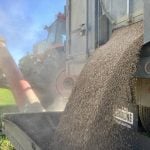If you’re looking to rent land from the new ag investment companies, you may have to convince Bryce Thompson that you’re the right farmer for the job. Here, he tells us how to do it
Saskatchewan farm boy Bryce Thompson walked into the boardroom of a skyscraper on Toronto’s Bay Street not knowing what to expect. He had an appointment to meet a wealthy landowner, that much was certain. But there was a kind of unreality about it, a clash of two stereotypes — a Prairie farmer and a Toronto investor. Would they even know how to speak the same language?
It turns out they didn’t, which is exactly why the meeting went so well.
“What is everyday conversation for us is new to them,” says Thompson, who emerged from the meeting feeling that his knowledge and experience had been highly valued. “They’ve never heard it before and they want to understand.”
Read Also

Are you ready for farm succession?
What motivates some farmers to make a succession plan while others don’t seem worried.
Thompson and partner Earl Smith had launched their Regina business called groPartners to specialize in what’s being called landlord management, linking landowners from across Canada to Prairie farmers. Only in their second year of operation, the company now manages the lease agreements for about 40,000 acres, and also provides agronomic and financial consulting.
Most of groPartners’ clients have made money in other industries and are investing in farmland because it’s safe, or sometimes because they have a family tie to the land. The landowners, not the farmers, pay the groPartners’ land management fees, so the owners’ interests are the company’s first priority. Generally such land investors want more than a rent cheque at the end of the year, however. They want a long-term relationship with the farmers they rent to, looking for someone who will care for their investment.
“Renting land brings inherent risk in maintaining the farm,” says Thompson. “Properly managing the relationships with landowners helps reduce this risk.”
Here are eight insights from Thompson about how to get picked to rent their land.
1. Build a farm resumé
In some areas the competition for land this winter has been so hot, local farmers are joking that it’s contributing to global warming.
For a recent land purchase in Saskatchewan, Thompson and Smith interviewed over 30 farmers and selected the top five to work with.
Once they establish that a farmer is interested in farming the land, Thompson and Smith go through an extensive discussion regarding the farm’s current practices, infrastructure, equipment, human resources, financial situation and future goals. They quickly weed out farmers who aren’t using up-to-date practices, tending to select higher-input farmers. They also assess the volume, type and quality of the farm’s equipment compared to how many acres it covers to help ensure timely operations on the land.
Thompson says landlords want to know what crops are going to be grown and what inputs are planned, including rotations, fertility and weed control.
Between Smith’s experience in agricultural loans and Thompson’s background as an agronomist, they can usually find out which farmers are well respected in an area. They make a point of trying to find younger, growing farms as they want to form relationships with the potential to last.
Generally, farmers with some off-farm experience in other industries understand other people’s perspective better and are more willing to find a win-win situation, says Thompson. Farmers should tell landlords about their experience, course accreditation and education.
Ohio State University’s fact sheet, Managing Landlord-Tenant Relationships: A Strategic Perspective, suggests providing landlords with a detailed resumé of the farming operation. This could include business objectives and philosophies, history of your business, education, tillage practices, equipment, land tenure, financial strength and relevant family information.
2. Communicate, communicate, comm…
Thompson remembers one farmer bragging he hadn’t had to talk to a landowner at all through a five-year lease. Then he was surprised at the end of the term when the landowner switched to another farmer who had taken the time to get to know him.
Thompson says most farmers are happy to communicate by text or email but most landlords want to talk to real people. “I create stability by keeping in touch with landowners,” he says.
Communicating helps build and maintain trust with the landowner and increases the chances of a long-term relationship, but it does take time and patience. Thompson and Smith select renters who are willing communicators, have a positive attitude and, while they are already doing a good job, are still looking to learn and improve.
The landowners Thompson deals with are very interested in agriculture but don’t have the time or the know-how to keep fully updated. They may read the headlines in the general press about high crop prices and food shortages but don’t necessarily understand how the commodity markets work, or the current costs and risks.
In Thompson’s experience, they basically want to know enough to be sure the practices being carried out on their land are sustainable and productive.
Also, most landowners want to believe the farmer looking after their land is a very good farmer, says Thompson. You don’t necessarily need to share your net worth, but be prepared to show where the money is coming from for next year’s inputs.
The type of rental agreement usually determines the amount of communication required. With cash-rent deals, Thompson contacts the landlords only a few times a year to let them know how the year is proceeding and to ensure things are in place for the following year.
In agreements where the landowner is more involved, such as a joint ventures (like a share crop with the landowners carrying some of the input risks), they communicate more, sometimes up to weekly. This includes several updates in the growing season on crop and market conditions, so there are no surprises to the landowner at harvest. This is especially important when unexpected events such as hail, frost, insect or disease outbreaks change the forecasted production.
“A conversation or two at harvest to let the landowner know how things are turning out is also important,” says Thompson. “These real-time updates maintain the landowners’ confidence.”
Mostly Thompson works to his client’s goals but also tries to match those goals with the reality that farm productivity depends on weather, pests and more.
“They come to us with a romanticized view of farming but soon realize that it’s a complex business,” Thompson says.
3. Make the owner feel like a farmer
Understanding that for some landowners it’s not all business also plays a part. “The landowners want to ensure the land is well cared for and get a fair annual return,” says Thompson. “However, they also generally have an emotional attachment, a pride of ownership.”
Accept it and consider it an opportunity, says Thompson. “Our experience is that it’s a good thing.”
Many groPartner clients were raised on farms and are looking for the emotional tie of owning land that they had as kids. If you take the time to explain modern farming practices, they’re more willing to enter agreements that help the farmer, and they will put value on the knowledge that their land is being cared for.
Conversely if you’re dealing with someone with zero emotional attachment, they’re more willing to dump the farmer to move on to one who offers them a couple dollars more per acre in rent. In Thompson’s experiences, the more removed landowners are from the farm, the more objective they are about expecting it to produce a return.
4. Be flexible on agreement type
Having lots of choices can be important, says Thompson. If farmers are flexible on the type of agreements they’ll enter into, they can increase their access to land.
For example, he vividly recalls a farmer he tried to work with who was willing to enter into only one type of agreement. It didn’t fit with the client, so the farmer missed the opportunity to grow his farm in an area where more land is hard to access.
In 1998, 60 professional farm managers responded to a mail survey sent to each of the 108 farm management companies operating in Illinois. They overwhelmingly agreed with Thompson that providing a menu of leasing options allows each party to express their preference and to negotiate the most satisfactory contract terms.
Typically, agreements are either cash rents paid at a fixed rate, or they’re flexible cash-rent or crop-share leases which are based on a predetermined division of revenue from the crop. To figure out which type is the most appropriate, Thompson assesses the landowner’s risk tolerance, financial situation and basically what the landlord wants out of the deal. Is the landowner highly dependent on the rent payment for food and shelter, or are they highly leveraged? If so, they’re probably not in a position to share risk and so Thompson will recommend a fixed cash rent. If the landowner is financially secure and has a good understanding of the risks involved in farming, then a shared-risk agreement might be a good option.
In Western Canada, share cropping, (giving the landowner a percentage of the sales of the crops) is almost extinct. Instead groPartners’ most common agreement is a joint-venture agreement. The landowner shares the production costs and shares in the profits, exposing them to the same down-side risks and upside potential as the farmer.
Also, the landowner is perceived as farming and can file taxes accordingly. However, Thompson is clear that tax management is not the main driver for landowners. “They see this as a way to help younger growing farmers access cash and share the risk with them and it exposes them to the full risk and reward of production farming.”
5. Be open to longer leases
One of the biggest risks for farmers today is the loss of their rental land. Their machinery assets are tied to a larger percentage of leased land. At the same time demand is pushing up rental rates. Owners are concerned they’ll miss out on increases and farmers are afraid they won’t be able to afford higher rates if commodity prices go down and input costs increase.
That uncertainty is often transcribed into shorter land lease terms. “The lengths of leases are probably less than they were 10 years ago,” says Thompson.
Longer-term agreements help farmers manage their farm business with longer-term planning. Five years is groPartners’ most common agreement with hopes that it will be a much longer relationship. Thompson finds it much easier to deal with landowners who have the intention of owning the land for a long time frame.
6. Bring your numbers
“Business-minded farmers recognize that in order for the agriculture industry to secure needed investment, landowners must receive reasonable annual returns,” says Thompson. “It should benefit all parties.”
One of the keys to making this a win-win situation is to ensure that your numbers are crunched before you meet with the landlords. Having your average cost of production and current level of return along with the financial reality calculated for some alternative lease agreements will go a long way to netting an agreement. It will also go a long way to debunking misconceptions.
Most landlords look to set a fair rate based on what others pay in the area. Others will set rental rates on a rate of return versus the dollars invested in the land. “Some of the more aggressive landowners are trying to obtain over six per cent,” says Thompson. “With the current run up in farmland values, areas can be anywhere from three to five per cent range.”
The vast majority of landowners want to see the farmer succeed, says Thompson. They don’t want to be trying to find a new farmer the next year. Part of the communication is to educate landowners that there are benefits in having the same farmer manage the land for a long time to ensure proper investment in fertility, weed control and other maintenance.
“Landowners with a good understanding of farm economics will also consider what the true costs and profit potential of the farmer are and try to adjust for this,” says Thompson.
For the landowners, having an intermediary sometimes increases confidence that a fair deal is in place, gives them confidence that the land is being properly maintained and allows them to enter into more complicated agreements. “If we were not involved they would not likely have either the time or understanding to enter into and maintain an agreement where production and cost risk is shared,” says Thompson.
7. Sign written agreements
Written agreements are a necessity to ensure there are no misunderstanding. “It means we must discuss things,” says Thompson.
This forced communication can include a clause to ensure the lease will continue for the duration of the contract even on death of the landowner. “With the amount of investment needed to farm today, if someone passes away or the farm is sold, it helps to have the farmer still tied to the agreement,” says Thompson.
8. Plan for the next generation
Connecting with the next generation of landowners or future land fund shareholders is an often forgotten way to potentially extend the agreement.
“Whether it’s a farmer’s grandchildren inheriting or outside investors who purchase farmland, the evolution of farming is dealing with people who are further removed from the farm,” says Thompson. “They’ll have a greater dependence on the farmer to make sure land is well looked after.” CG














